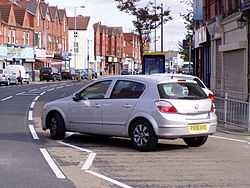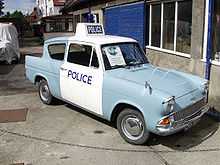Panda car

The phrase panda car refers to a small or medium-sized police car operated by British police forces.
History of the term
Panda cars were named after pandas because they were originally painted with large panels of black and white, or light blue and white.

The first use of panda cars seems to have been in Lancashire Constabulary area in about 1965, the chief constable described the use of blue and white Ford Anglia panda cars in Kirkby in an article in The Times on 26 January 1966. These were blue with a white line painted around them. In 1967, the Dunbartonshire force bought two Hillman Imps (subsequently nicknamed Pinky and Perky) for escort duties on the A82 road; one blue and one white. The boot lids, bonnets, and doors were then swapped to create a panda car style scheme.[1]
In the 1980s police cars in the UK began to be ordered in white to save acquisition costs, usually with orange or red "jam sandwich" reflective stripes. Today, patrol cars use Battenburg markings or stripes, although many forces still use a mainly white colour scheme. The name panda car or panda is still sometimes used.
Roles
In many areas, the panda car replaced the traditional "bobby on the beat", when it was seen that larger suburban or rural areas could be more effectively patrolled by officers in cars, as opposed to on foot, bicycles, or motorcycles. The provision of shelter from the weather and a two-way radio were also benefits.
The panda is distinct from the "area car", a larger and more powerful vehicle which acts as support to the beat constables, usually carrying two officers.
Current usage within the Metropolitan Police Service uses the term "panda car" to refer specifically to a marked car driven by a basic driver (i.e., one constrained to drive within normal traffic rules, and who may not use the vehicle's siren), as opposed to an IRV—"immediate response vehicle"—which could be exactly the same vehicle but driven by a response driver (i.e., one trained and permitted to disregard certain traffic laws and use the siren, as one would normally expect from police vehicles). The callsign attached to the vehicle for the duration of the shift should normally make it clear whether it is functioning as a panda or IRV at the time. These vehicles are sometimes referred to as a "lemon sandwich", if they have/use the colour scheme of white with a yellow stripe.
References
- Article by the Chief Constable of Lancashire in The Times (Mobility Answer to Police Shortage (News) Colonel T. E. St. Johnston - The Times, Wednesday, 26 January 1966; pg. 13; Issue 56539; col F)
Models of car used
Many models of panda car have been or are used by British police forces. Among the most popular are or have been:
- Audi A4
- Audi A6
- Austin Maestro
- Austin Montego
- Austin/Rover Metro
- BMW 3 Series
- BMW 5 Series
- BMW X5
- Chevrolet Captiva
- Ford Anglia
- Ford Escort
- Ford Fiesta
- Ford Focus
- Ford Galaxy
- Ford Mondeo
- Ford S-Max
- Ford Sierra
- Ford Transit
- Ford Zephyr
- Hillman Imp
- Honda Accord
- Honda CR-V
- Hyundai i30
- Hyundai ix35
- Jaguar X-Type
- Jaguar XF
- Land Rover Discovery
- Land Rover Freelander
- Lexus RX
- Leyland Sherpa
- Mercedes-Benz Sprinter
- MG ZS
- MG ZT
- Mini
- Mitsubishi Outlander
- Mitsubishi Shogun
- Morris LD
- Morris Traveller
- Nissan Pathfinder
- Peugeot Expert
- Peugeot 206
- Peugeot 306
- Peugeot 307
- Peugeot 405
- Peugeot 406
- Peugeot 407
- Peugeot 806
- Proton Impian
- Proton Wira/Persona
- Renault Espace
- Renault Laguna
- Rover 600
- Rover 800
- Rover 75
- Rover 3500 (P6)
- Rover 3500 (SD1)
- Saab 9-5
- Škoda Fabia
- Škoda Octavia
- Škoda Superb
- Smart ED
- Smart Fortwo
- Vauxhall Corsa
- Vauxhall Antara
- Vauxhall Astra
- Vauxhall Vectra
- Vauxhall Frontera
- Vauxhall Insignia
- Vauxhall Senator
- Vauxhall Omega
- Vauxhall Zafira
- Vauxhall Sintra
- Volkswagen Passat
- Volkswagen Sharan
- Volvo S60
- Volvo S80
- Volvo V50
- Volvo V70
- Volvo XC70
- Volvo XC90